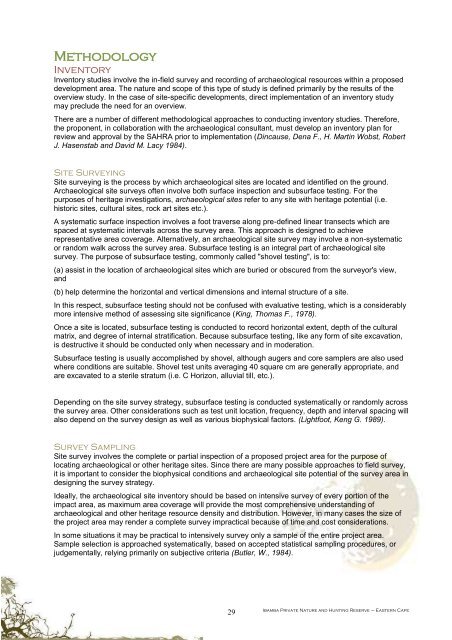Heritage Impact Assessment - SAHRA
Heritage Impact Assessment - SAHRA
Heritage Impact Assessment - SAHRA
You also want an ePaper? Increase the reach of your titles
YUMPU automatically turns print PDFs into web optimized ePapers that Google loves.
MethodologyInventoryInventory studies involve the in-field survey and recording of archaeological resources within a proposeddevelopment area. The nature and scope of this type of study is defined primarily by the results of theoverview study. In the case of site-specific developments, direct implementation of an inventory studymay preclude the need for an overview.There are a number of different methodological approaches to conducting inventory studies. Therefore,the proponent, in collaboration with the archaeological consultant, must develop an inventory plan forreview and approval by the <strong>SAHRA</strong> prior to implementation (Dincause, Dena F., H. Martin Wobst, RobertJ. Hasenstab and David M. Lacy 1984).Site SurveyingSite surveying is the process by which archaeological sites are located and identified on the ground.Archaeological site surveys often involve both surface inspection and subsurface testing. For thepurposes of heritage investigations, archaeological sites refer to any site with heritage potential (i.e.historic sites, cultural sites, rock art sites etc.).A systematic surface inspection involves a foot traverse along pre-defined linear transects which arespaced at systematic intervals across the survey area. This approach is designed to achieverepresentative area coverage. Alternatively, an archaeological site survey may involve a non-systematicor random walk across the survey area. Subsurface testing is an integral part of archaeological sitesurvey. The purpose of subsurface testing, commonly called "shovel testing", is to:(a) assist in the location of archaeological sites which are buried or obscured from the surveyor's view,and(b) help determine the horizontal and vertical dimensions and internal structure of a site.In this respect, subsurface testing should not be confused with evaluative testing, which is a considerablymore intensive method of assessing site significance (King, Thomas F., 1978).Once a site is located, subsurface testing is conducted to record horizontal extent, depth of the culturalmatrix, and degree of internal stratification. Because subsurface testing, like any form of site excavation,is destructive it should be conducted only when necessary and in moderation.Subsurface testing is usually accomplished by shovel, although augers and core samplers are also usedwhere conditions are suitable. Shovel test units averaging 40 square cm are generally appropriate, andare excavated to a sterile stratum (i.e. C Horizon, alluvial till, etc.).Depending on the site survey strategy, subsurface testing is conducted systematically or randomly acrossthe survey area. Other considerations such as test unit location, frequency, depth and interval spacing willalso depend on the survey design as well as various biophysical factors. (Lightfoot, Keng G. 1989).Survey SamplingSite survey involves the complete or partial inspection of a proposed project area for the purpose oflocating archaeological or other heritage sites. Since there are many possible approaches to field survey,it is important to consider the biophysical conditions and archaeological site potential of the survey area indesigning the survey strategy.Ideally, the archaeological site inventory should be based on intensive survey of every portion of theimpact area, as maximum area coverage will provide the most comprehensive understanding ofarchaeological and other heritage resource density and distribution. However, in many cases the size ofthe project area may render a complete survey impractical because of time and cost considerations.In some situations it may be practical to intensively survey only a sample of the entire project area.Sample selection is approached systematically, based on accepted statistical sampling procedures, orjudgementally, relying primarily on subjective criteria (Butler, W., 1984).29Ibamba Private Nature and Hunting Reserve – Eastern Cape
















